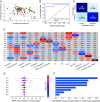Micro magnetic resonance spectroscopy for noninvasive metabolic screening of mammalian embryos and oocytes
- PMID: 40720661
- PMCID: PMC12337278
- DOI: 10.1073/pnas.2424459122
Micro magnetic resonance spectroscopy for noninvasive metabolic screening of mammalian embryos and oocytes
Abstract
Analyzing cellular health and metabolism without compromising cell integrity is a major challenge. We present a noninvasive technique using micro magnetic resonance spectroscopy (micro MRS) for nondestructive metabolic fingerprinting at the single-cell scale. This is an application of micro MRS to bovine preimplantation embryos (~8 cells) and oocytes (single cell), with measurements performed on a total of over 150 samples. Among various applications, this method holds significant potential for assisted reproductive technologies (ART), where metabolic assessments of preimplantation embryos could improve treatment outcomes. Early results indicate that classification models using micro MRS data effectively distinguish embryos with high developmental potential and show correlation with oocytes maturity. Furthermore, a multigenerational safety study in a mouse model revealed no adverse effects from embryo exposure to static magnetic field. These findings indicate that micro MRS is a promising, safe tool for assessing embryo metabolism, potentially improving the efficiency and outcomes of ART.
Keywords: Magnetic Resonance Spectroscopy; metabolic fingerprinting; micro MRS; non-invasive embryo screening; single-cell MRS.
Conflict of interest statement
Competing interests statement:Marco Grisi has relevant ownership in Annaida as he is the Founder. Marco Grisi is inventor of a patent related to this work (2018, PCT/IB2018/057348).
Figures




Similar articles
-
Novel application of metabolic imaging of early embryos using a light-sheet on-a-chip device: a proof-of-concept study.Hum Reprod. 2025 Jan 1;40(1):41-55. doi: 10.1093/humrep/deae249. Hum Reprod. 2025. PMID: 39521726 Free PMC article.
-
Metabolomics for improving pregnancy outcomes in women undergoing assisted reproductive technologies.Cochrane Database Syst Rev. 2018 Mar 16;3(3):CD011872. doi: 10.1002/14651858.CD011872.pub3. Cochrane Database Syst Rev. 2018. PMID: 29547689 Free PMC article.
-
Metabolomics for improving pregnancy outcomes in women undergoing assisted reproductive technologies.Cochrane Database Syst Rev. 2017 May 23;5(5):CD011872. doi: 10.1002/14651858.CD011872.pub2. Cochrane Database Syst Rev. 2017. Update in: Cochrane Database Syst Rev. 2018 Mar 16;3:CD011872. doi: 10.1002/14651858.CD011872.pub3. PMID: 28534597 Free PMC article. Updated.
-
Cleavage-stage versus blastocyst-stage embryo transfer in assisted reproductive technology.Cochrane Database Syst Rev. 2022 May 19;5(5):CD002118. doi: 10.1002/14651858.CD002118.pub6. Cochrane Database Syst Rev. 2022. PMID: 35588094 Free PMC article.
-
Oocyte, embryo and blastocyst cryopreservation in ART: systematic review and meta-analysis comparing slow-freezing versus vitrification to produce evidence for the development of global guidance.Hum Reprod Update. 2017 Mar 1;23(2):139-155. doi: 10.1093/humupd/dmw038. Hum Reprod Update. 2017. PMID: 27827818 Free PMC article.
References
-
- Weinerman R., In vitro fertilization (IVF): Where are we now? Birth Defects Res. 110, 623–624 (2018). - PubMed
-
- SART, S.f.A.R.T. Final National Summary Report for 2021. (2024), https://sartcorsonline.com/CSR/PublicSnapshotReport?ClinicPKID=0&reporti.... Accessed 28 June 2025.

